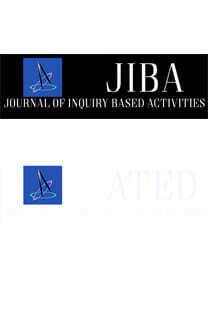NAKLİYE FİRMALARI İÇİN TAŞINMA PROBLEMİ: MÜHENDİSLİK TASARIM ODAKLI ETKİNLİK ÖRNEĞİ
TRANSPORTATION PROBLEM FOR MOVING COMPANIES: AN EXAMPLE ACTIVITY WITH AN ENGINEERING DESIGN FOCUS
___
- Baran, E., Canbazoglu Bilici, S., Mesutoglu, C., & Ocak, C. (2016). Moving STEM beyond schools: Students’ perceptions about an out-of-school STEM education program. International Journal of Education in Mathematics, Science and Technology, 4(1), 9-19.
- Bicer, A., Beodeker, P., Capraro, R. M., & Capraro, M. M. (2015). The effects of STEM PBL on students’ mathematical and scientific vocabulary knowledge. International Journal of Contemporary Educational Research, 2(2), 69-75.
- Bozkurt Altan, E. (2017a). Tasarım temelli öğrenme ve probleme dayalı STEM uygulamaları. S. Çepni (Ed.) içinde, Kuramdan uygulamaya STEM eğitimi (ss. 165-199). Ankara: Pegem Akademi.
- Bozkurt Altan, E. (2017b). Fen-teknoloji-mühendislik ve matematik (FeTeMM-STEM) eğitimi. H. G. Hastürk (Ed.) içinde, Teoriden pratiğe fen bilimleri öğretimi (ss. 354-388). Ankara: Pegem Akademi.
- Bozkurt Altan, E., & Hacıoğlu, Y. (2018). Fen bilimleri öğretmenlerinin derslerinde STEM odaklı etkinlikler gerçekleştirmek üzere geliştirdikleri problem durumlarının incelenmesi. Necatibey Egitim Fakültesi Elektronik Fen ve Matematik Eğitimi Dergisi, 12(2), 487-507.
- Bozkurt Altan, E., Üçüncüoğlu, İ., & Öztürk, N. (2019). Preparation of out-of-school learning environment based on science, technology, engineering, and mathematics education and investigating its effects. Science Education International, 30(2), 138-148.
- Breiner, J. M., Harkness, S. S., Johnson, C. C., & Koehler, C. M. (2012). What is STEM? A discussion about conceptions of stem in education and partnerships. School Science and Mathematics, 112(1), 3-11.
- Brunsell, E. (2012). The engineering design process. In E. Brunsell (Ed.), Integrating engineering + science in your classroom (pp. 3-5). Arlington, Virginia: National Science Teacher Association Press.
- Chiu, A., Price, C. A., & Ovrahim, E. (2015, April). Supporting elementary and middle school STEM education at the whole school level: A review of the literature. Paper presented at NARST 2015 Annual Conference, Chicago, IL.
- Çorlu, M. S. (2017). STEM: bütünleşik öğretmenlik çerçevesi. M. S. Corlu & E. Çallı (Editörler) içinde, STEM kuram ve uygulamaları (ss. 1-10). Ankara: Pusula Yayıncılık.
- Ercan S. (2014). Fen eğitiminde mühendislik uygulamalarının kullanımı: Tasarım temelli fen eğitimi (Yayınlanmamış doktora tezi). Marmara Üniversitesi, İstanbul.
- Felix, A. L. (2010, April). Design-based science for STEM student recruitment and teacher Professional development. Paper presented at Mid-Atlantic ASEE Conference, Villanova.
- Fortus, D., Dershimer, R. C., Krajcik, J., Marx, R. W., & Mamlok-Naaman, R. (2005). Design-based science and real-world problem-solving. International Journal of Science Education, 27(7), 855-879.
- Harrel, P. E. (2010). Teaching an integrated science curriculum: Linking teacher knowledge and teaching assignments. Issues in Teacher Education, 19(1), 145-165.
- Hmelo, C. E., Holton, D., & Kolodner, J. L. (2000). Designing to learn about complex systems. The Journal of the Learning Sciences, 9(3), 247–298.
- Hynes, M., Portsmore, M., Dare, E., Milto, E., Rogers, C., Hammer, D. & Carberry, A. (2011). Infusing engineering design into high school STEM courses. National Center for Engineering and Technology Education. Retrieved from ERIC database (ED537364) at https://files.eric.ed.gov/fulltext/ED537364.pdf
- Karahan, E. (2017). STEM eğitim merkezleri. S. Çepni (Ed.) içinde, Kuramdan uygulamaya STEM+A+E Eğitimi (ss. 93-113). Ankara: Pegem Akademi.
- Karahan, E., & Bozkurt, G. (2017). STEM eğitiminde matematik odaklı gerçek dünya problemleri ve matematiksel modelleme. S. Çepni (Ed.) içinde, Kuramdan uygulamaya STEM+A+E Eğitimi (ss. 353-372). Ankara: Pegem Akademi.
- Milli Eğitim Bakanlığı. (2017). Fen bilimleri dersi programı, 3.- 8. sınıflar taslak öğretim programı. Ankara: MEB Yayıncılık.
- Milli Eğitim Bakanlığı. (2018). Fen bilimleri dersi programı, 3.- 8. sınıflar. Ankara: MEB Yayıncılık.
- National Academy of Engineering. (2010). Standards for K-12 engineering education? Washington, DC: National Academies Press.
- National Academy of Engineering & National Research Council. (2009). Engineering in K-12 education understanding the status and improving the prospects. Washington, DC: National Academies Press.
- National Academy of Engineering & National Research Council. (2014). STEM Integration in K12 Education status, prospects, and an agenda for research. Washington, DC: National Academies Press.
- National Research Council. (2012). A Framework for k-12 science education: practices, crosscutting concepts, and core ideas. Washington DC: The National Academic Press.
- Roehrig, G. H., Moore, T. J., Wang, H. H., & Park, M. S. (2012). Is adding the e enough? Investigating the impact of K‐12 engineering standards on the implementation of STEM integration. School Science and Mathematics, 112(1), 31-44.
- Sanders, M. (2009). STEM, STEM education, STEMmania. The Technology Teacher, 68(4), 20-26.
- Shaughnessy, M. (2013). Mathematics in a STEM context. Mathematics Teaching in the Middle School, 18(6), 324.
- Siew, N. M. (2017, May). Integrating STEM in an engineering design process: The learning experience of rural secondary school students in an outreach challenge program. Paper presented at the International Conference on Education in Mathematics, Science & Technology (ICEMST), Aydın, Turkey.
- Smith, J., & Karr-Kidwell, P. (2000). The interdisciplinary curriculum: A literary review and a manual for administrators and teachers. Retrieved from ERIC database (ED443172) at https://files.eric.ed.gov/fulltext/ED443172.pdf
- Sullivan, F. R. (2008). Robotics and science literacy: Thinking skills, science process skills and systems understanding. Journal of Research in Science Teaching, 45(3), 373–394.
- Şahin, A., Ayar, M. C., & Adıgüzel, T. (2014). STEM related after-school program activities and associated outcomes on student learning. Educational Science: Theory & Practice, 14(1), 309-322.
- ISSN: 2146-5711
- Yayın Aralığı: Yılda 2 Sayı
- Başlangıç: 2011
- Yayıncı: Evrim Erbilgin
REFLEKS YAYI MODELİ OLUŞTURALIM: BİR STEM ETKİNLİĞİ
DOĞADA TASARLANAN SORGULAMA TEMELLİ BİR BİLİM ETKİNLİĞİ: MİLLİ PARK’IN BİYOÇEŞİTLİLİĞİ TEHLİKEDE!
BİLİMİN DOĞASI ÖĞRETİMİNDE BİLİM TARİHİNİN NASIL KULLANILABİLECEĞİNİ GÖSTEREN BİR ETKİNLİK
ATMOSFERDEKİ SICAKLIK DEĞİŞİMİNDE ROL OYNAYAN GAZLARIN ETKİSİ: BİR STEM ETKİNLİĞİ
AN ACTIVITY SHOWING HOW TO USE HISTORY OF SCIENCE IN TEACHING NATURE OF SCIENCE
NAKLİYE FİRMALARI İÇİN TAŞINMA PROBLEMİ: MÜHENDİSLİK TASARIM ODAKLI ETKİNLİK ÖRNEĞİ
Esra BOZKURT ALTAN, İrem ÜÇÜNCÜOĞLU, Hüseyincan ÖZEK
ELEMENTLER VE PERİYODİK SİSTEMİN ÖĞRENİLMESİNE İLİŞKİN ETKİNLİK ÖRNEĞİ
LET’S FORM A REFLEX ARC MODEL: A STEM ACTIVITY
REHBERLİ ARAŞTIRMA-SORGULAMA YAKLAŞIMINA UYGUN WEB DESTEKLİ FEN MATERYALİ GELİŞTİRİLMESİ: KEMİKLER
